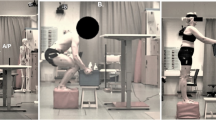Summary
The purpose of this study was to evaluate the ergonomic risk factors associated with manual lifting tasks using surface electromyography (EMG). 13 volunteers lifted loads of 6 and 13 kg at two speeds and at two horizontal distances in 3 different postures and three boxes of different sizes, from floor to knuckle height, performing 72 lifting tasks. For each lift, the surface electro-myography signals from the erector spinae muscles, bilaterally at T10 and L3, was recorded. The ergonomic risk factors associated with manual lifting tasks were evaluated by comparing the average amplitude of EMG signals from the erector spinae muscles. The EMG average amplitude for lifting the load of 13 kg was 14.3% greater than that for lifting the load of 6 kg (t=−10.93,P<0.01). The EMG average amplitude at the site of L3 was 10.3% greater than that at the site of T10 (t=−7.98,P<0.01). The EMG average amplitude when performing “fast” lift was 5.9% greater than the “slow” lift (t=−4.63,P<0.01). The posture of lifting affected the EMG average amplitude. It was lowest with semi-squat posture and greatest with squat posture (F=27. 76,P<0.01). The result of multiple stepwise regression analysis showed that the loads of lifting, the size of box, horizontal distance, posture of lifting, the site of the spine subjected to force, lifting speed were the factors affecting the EMG average amplitude. The most significant factor was the loads of lifting, followed by the site of the spine subjected to force and the lifting speed in terms of risk. The ergonomic risk factors associated with manual lifting tasks includes the loads, posture, lifting speed, horizontal distance, the site of the spine subjected to force etc. The results of signal amplitude of EMG from the erector spinae muscles showed that semi-squat posture is the best posture for lifting tasks.
Similar content being viewed by others
References
Straker L M. An overview of manual handling injury statistics in Western Australia. Int J Ind Ergon. 1999, 24: 357
Straker L, Cain C. Psychophysical and physiological comparison of squat and semi-squat lifting by young males. Occup Ergon, 1999, 1: 29
Ferguson S A, Marras W S. A literature review of low back Disorder surveillance measures and risk factors. Clin Biomech, 1997, 12: 211
Straker L. Evidence to support using squat, semi-squat and stoop postures to lift low-lying objects. Int J Ind Ergon, 2003, 31: 149
Dolan P, Adams M. The relationship between EMG activity and extensor moment generation in the erector spinae muscles during bending and lifting activities. J Biomech. 1993; 26: 513
McLean L, Chislett M, Keith Met al. The effect of head position, electrode site, movement and smoothing window in the determination of a reliable maximum Voluntary activation of the upper trapezius muscle. J Electromyogr Kinesiol, 2003, 13: 169
Dolan P, Adams M. Repetitive lifting tasks fatigue the back muscles and increase the bending moment acting on the lumbar spine. J Biomech, 1998, 31: 713
Sedgwick A W, Gormley J T. Training in lifting: An unresolved ergonomie issue? Appl Ergon, 1998, 29: 395
Straker L, Cain C. Psychophysical and physiological comparison of squat and semi-squat lifting by young male. J Occup Ergon, 1999, 1: 29
Straker L, Duncan P. Psychophysical and psychological comparison of squat and stoop lifting by young females. Aust J Physiother, 2000, 16: 27
Author information
Authors and Affiliations
Additional information
CHEN Jing, female, born in 1963, Associate Professor
This work was supported by the Deutsche Akademische Austauschdienst (DAAD) and the Telemetry System BIOTEL 44 was provide by DAAD.
Rights and permissions
About this article
Cite this article
Jing, C., Lei, Y., Jiasun, D. et al. The application of surface electromyography in the assessment of ergonomic risk factors associated with manual lifting tasks. Current Medical Science 24, 552–555 (2004). https://doi.org/10.1007/BF02911352
Received:
Published:
Issue Date:
DOI: https://doi.org/10.1007/BF02911352




